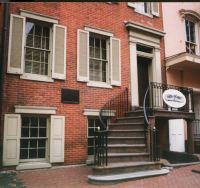511 10th Street, N.W.
Washington. DC, 20004
Hours: Daily: 9 a.m. to 5 p.m.; closed December 25.
Ford's Theatre is an active theatre and may close temporarily with little notice, especially just before and after productions for rehearsals and set changes. The theatre will also be closed during matinees.The Lincoln Museum and the Petersen House will remain open for tours during matinees and rehearsals.Please review our in-depth page for the ranger talk schedule.We HIGHLY RECOMMEND that you use public transportation to arrive in Washington, DC as there will be VERY limited parking, various road closures throughout the day, and congestion due to crowds. Be prepared to walk to most locations.
Ford's Theatre
National Historic Site
The House Where Lincoln Died/ Petersen's Boarding House
April 14-15, 1865
The entourage carrying the mortally wounded President proceeded slowly down the staircase in Ford's Theatre and then exited to 10th Street. Dr. Charles Leale, age 23, who was attending Lincoln, described the events which followed:
The crowd in the street completely obstructed the doorway and a captain, whose services proved invaluable all through the night, came to me, saying: "Surgeon, give me your commands and I will see that they are obeyed." I asked him to clear a passage to the nearest house opposite. He had on side arms and drew his sword. With the sword and word of command he cleared the way. We slowly crossed the street. It was necessary to stop several times to give me the opportunity to remove the clot of blood from the opening to the wound. A barrier of men had been formed to keep back the crowds on each side of an open space leading to the house. Those who went ahead reported that the house directly opposite the theatre was closed. I saw a man standing at the door of Mr. Petersen's house, diagonally opposite, holding a lighted candle in his hand and beckoning us to enter...1
Henry Safford, unlike the other boarders who went out that night, decided to spend the evening in the Petersen boarding house. In a 1903 letter, wrote:
I had spent the evening reading in the front room when, about ten o'clock, hearing a disturbance outside, I went to the window and learned that Lincoln had been shot. I hastened down to the front door, and, while standing on the upper steps, the President was brought out of the theatre and into the street towards where I stood. Suddenly those carrying him seemed in doubt as to where they would take him. Quickly realizing the cause of their hesitation, although being alone in the house, I took the responsibility of crying out, "Bring him in here, Bring him in here", which invitation was immediately accepted and he was taken to the bedroom in the rear of the parlors and placed on a bed...2
Mrs. Lincoln was escorted across the street by Major Rathbone, who had been in the box with the First Couple. Rathbone, bleeding severely from the knife wound in his arm, collapsed due to loss of blood after arriving at the Petersen House .
Mrs. Lincoln was joined by Elizabeth Dixon, a close friend of her's and Miss Clara Harris, Rathbone's fiancee. Mary stayed in the Petersen House for the entire night. George and Helga Francis, who rented the front rooms were asked to go downstairs for the evening.
During the night and early morning, guards patrolled outside to prevent onlookers from coming inside the house. A parade of government officials and physicians was allowed to come inside and pay respects to the unconscious President. One of the officials was the Secretary of the Navy, Gideon Welles, who recorded in his diary:
"The giant sufferer lay extended diagonally across the bed , which was not long enough for him. He had been stripped of his clothes. His large arms, which were occasionally exposed, were of a size which one would scarce have expected from his spare appearance. His slow, full respiration lifted the clothes with each breath that he took. His features were calm and striking. I had never seen them appear to better advantage than for the first hour, perhaps, that I was there. After that, his right eye began to swell and that part of his face became discolored..."3
For medical treatment, the physicians continually removed blood clots which formed over the wound where the bullet had entered Lincoln's head. This process relieved the pressure on the brain and maintained breathing. However, the external and internal hemorrhaging continued throughout the night so that on the next day, April 15, 1865, at 7:22 a.m., a doctor leaned over the president and felt his final breath. Lincoln was fifty-six years old.
1 Dr. Charles Leale letter to General Benjamin Butler, 1867, Ford's Theatre National Historic Site.
2 Henry Safford letter to Osborn Oldroyd, 1901, Ford's Theatre National Historic Site.
3 Diary of Gideon Welles, New York: Houghton, Mifflin, and Company, 1911, pp.286-7.



